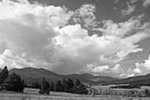MAXWELL NATIONAL WILDLIFE REFUGE
MAXWELL NATIONAL WILDLIFE REFUGEP.O. Box 276
Maxwell, New Mexico 87728
Located in the high central plains of northeastern New Mexico, Maxwell National Wildlife Refuge was established in 1965 as a feeding and resting area for migratory birds. Over 350 acres of the Refuge are planted with wheat, corn, barley, and alfalfa to provide food for resident and migratory wildlife. Visitors may see bald and golden eagles, falcons, hawks, sandhill cranes, ducks, white pelicans, burrowing owls, great horned owls, black-tailed prairie dogs, coyotes, mule deer, white-tailed deer, and the occasional elk.
The refuge has approximately 2200 acres of both healthy and disturbed short-grass prairie habitat, some of which is in the process of being restored. The environmental conditions in a prairie can be extreme: intense sunlight, drought, late spring snows, and high winds. Up to two-thirds of a prairie plant is contained below ground in its root mass, which helps the plant tolerate these extreme conditions. The roots help the plant take up nutrients and water from the soil. The prairie varies seasonally both in color and height. The dominant species include buffalo grass, blue grama, western wheatgrass, alkali sacaton, and red three-awn. Early in spring the prairie is much shorter with some small wildflowers blooming. The prairie reaches its peak color in July when most plants are blooming. Later in the season, the prairie is dominated by tall grasses, which give the prairie its beautiful fall color of orange, brown, and purple.
Vastly different concepts of land use and ownership can be seen in the history of Colfax County and northeastern New Mexico. Plains indians hunted, fished, and traded here for centuries but did not own title to the land.
Apache, Navajo, and Pueblo Indians crossed the plains in search of food and trade goods but did not create permanent settlements here.
Communities of Spanish and Mexican farmers and cattleman appeared around 1800, which were eventually integrated with European settlers with the eastern United States.
The purchase of these private lands for the creation of Maxwell NWR began in 1966 under the Migratory Bird Conservation Act. Concentrations of migrating birds, particularly geese, in the Central Flyway were creating intense crop depredation problems in some areas. The U.S. Fish and Wildlife Service began purchasing scattered tracts of land to provide waterfowl habitat in a broad area to better distribute migrating birds and alleviate crop depredation problems, thereby creating Maxwell National Wildlife Refuge.


